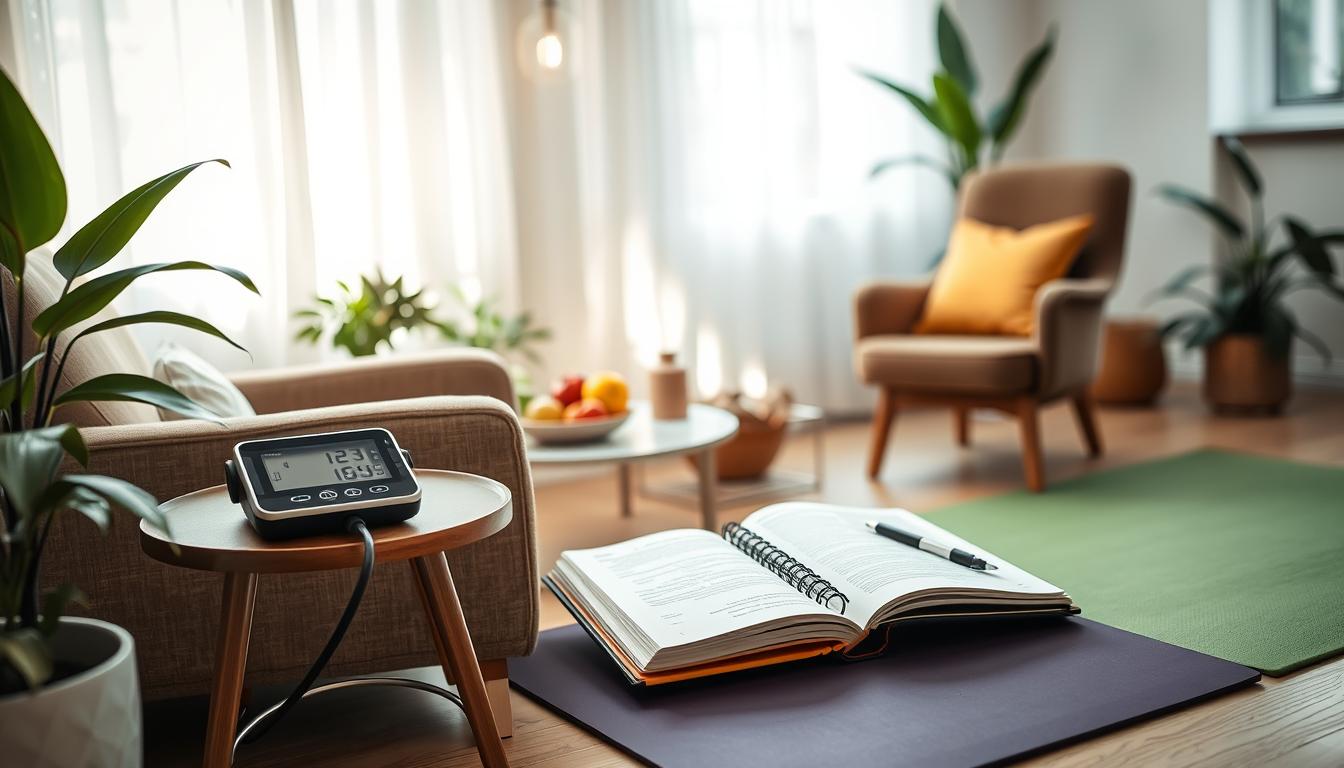Do you struggle with high blood pressure, or hypertension? You’re not alone. This serious condition can lead to heart disease, stroke, and kidney failure if not treated. But, you can control your health by making simple changes at home.
Key Takeaways
- Hypertension can be effectively managed through lifestyle changes and home-based strategies.
- Regular monitoring of blood pressure at home is crucial for tracking the effectiveness of your treatment plan.
- A healthy diet, regular exercise, and stress management are essential for controlling high blood pressure.
- Limiting sodium and alcohol intake, as well as quitting smoking, can significantly improve blood pressure levels.
- Involving your healthcare team is important for developing a comprehensive treatment approach and ensuring optimal results.
Understanding High Blood Pressure
High blood pressure, also known as hypertension, is when blood pressure is too high. A normal reading is under 120/80 mm Hg. High blood pressure is 130/80 mm Hg or higher.
What is High Blood Pressure?
Hypertension is a common health issue affecting millions globally. It makes the heart work harder to pump blood. This can lead to serious health problems if not managed.
Risks and Complications of Uncontrolled Hypertension
Uncontrolled hypertension raises the risk of serious health issues. These include heart attack, stroke, kidney disease, and vision problems. It’s vital to understand these risks to control high blood pressure.
- About 6 out of 10 people with diabetes also have high blood pressure.
- Smoking greatly increases the risk of high blood pressure, heart disease, heart attack, and stroke.
- High blood pressure can lead to serious health conditions, including stroke, heart attack, heart failure, kidney disease, and early death.
- As individuals age, the likelihood of having high blood pressure increases due to blood vessel stiffness.
Understanding the need for healthy blood pressure levels is key. It helps individuals manage their hypertension and lower the risk of serious complications.
Lose Extra Weight and Watch Your Waistline
Keeping a healthy weight is key to managing high blood pressure. Being overweight or obese can raise your blood pressure. Even a small weight loss can help lower it.
Your waist size matters too. Excess weight around the midsection increases hypertension risk. Aim for a waist of less than 40 inches for men and less than 35 inches for women. These numbers can vary by ethnicity.
Losing weight and watching your waistline can control hypertension. It also reduces the risk of health problems linked to it.
The American Heart Association (AHA) says losing 10 pounds can lower blood pressure for those who are overweight or obese. More than half of U.S. adults are overweight. A waist over 35 inches for women or 40 inches for men is unhealthy.
| Metric | Healthy Range | Unhealthy Range |
|---|---|---|
| Body Mass Index (BMI) | 18.5 to 24.9 | 25 or higher |
| Waist Circumference | Less than 35 inches (women) Less than 40 inches (men) |
35 inches or more (women) 40 inches or more (men) |
By keeping a healthy weight loss for high blood pressure, healthy waist size, and body mass index, you can manage hypertension well. This reduces the risk of health complications.
Exercise Regularly
Regular physical activity is key in managing hypertension. Aerobic exercises like walking, jogging, cycling, and swimming can lower blood pressure by 5 to 8 mm Hg. Strength training, done at least two days a week, also helps reduce high blood pressure.
Types of Exercises to Lower Blood Pressure
High-intensity interval training (HIIT) is effective in lowering blood pressure. It involves short bursts of intense activity followed by lighter periods. This exercise can lower blood pressure more than traditional aerobic exercise.
- Aerobic exercise: Walking, jogging, cycling, swimming, and other activities that get your heart rate up and keep it elevated for an extended period.
- Strength training: Resistance exercises, such as weightlifting, can help build muscle and improve cardiovascular health.
- High-intensity interval training (HIIT): Short bursts of intense exercise followed by periods of rest or lighter activity.
Starting an Exercise Routine
When starting an exercise routine, talk to a healthcare professional. They can create a safe plan that fits your needs and fitness level. They’ll help you set the right intensity and duration and check your progress.
“Regular exercise can lead to maintaining a healthy weight, with even a 5-pound weight loss potentially lowering blood pressure.”
Start slowly and increase your workouts gradually to avoid injury. Always warm up before exercising and cool down afterward. This helps prevent injuries and aids in recovery.
Eat a Healthy Diet
Choosing a diet full of nutrients is key to managing high blood pressure. The Dietary Approaches to Stop Hypertension (DASH) diet is especially good at lowering blood pressure. It focuses on whole foods and limits unhealthy stuff.
The DASH Diet for Hypertension
The DASH diet is all about eating whole grains, fruits, veggies, low-fat dairy, lean proteins, and healthy fats. It cuts down on sodium, saturated fats, and sugars. This diet can lower blood pressure by up to 11 mm Hg. It’s tasty, flexible, and simple to stick to, making it a great choice for managing diet for high blood pressure and DASH diet for hypertension.
Some key features of the DASH diet include:
- Grains: 6-8 servings per day, focusing on whole grains
- Vegetables: 4-5 servings per day
- Fruits: 4-5 servings per day
- Low-fat or fat-free dairy: 2-3 servings per day
- Lean meats, poultry, and fish: 6 or fewer 1-ounce servings per day
- Nuts, seeds, and legumes: 4-5 servings per week
- Fats and oils: 2-3 servings per day
- Sweets: 5 or fewer servings per week
The DASH diet is great because it’s rich in potassium-rich foods and low in low sodium diet. It helps manage hypertension and boosts heart health.
| Food Group | Servings per Day (2,000-calorie DASH diet) |
|---|---|
| Grains | 6-8 |
| Vegetables | 4-5 |
| Fruits | 4-5 |
| Low-fat or fat-free dairy | 2-3 |
| Lean meats, poultry, and fish | 6 or fewer 1-ounce servings |
| Nuts, seeds, and legumes | 4-5 servings per week |
| Fats and oils | 2-3 |
| Sweets | 5 or fewer servings per week |
“The DASH diet, rich in fruits, vegetables, whole grains, fish, poultry, nuts, legumes, and low-fat dairy, is linked to reduced risks of coronary artery disease and stroke.”
Reduce Salt and Sodium Intake
It’s key to cut down on sodium to control high blood pressure. The American Heart Association suggests eating no more than 2,300 mg of sodium daily. Aim for 1,500 mg or less if you can. Reading food labels and picking low-sodium options are crucial steps.
Stay away from processed and canned foods, as they are high in sodium. Instead, choose fresh, whole foods. Use herbs, spices, and other ingredients to add flavor without salt. This method not only lowers sodium but also brings out the natural taste of your food.
Reading Food Labels for Sodium Content
When you shop, make sure to check the Nutrition Facts label. Look for sodium content and pick items with less than 140 mg per serving. Opting for low-sodium or no-salt-added products can greatly reduce your sodium intake.
- Avoid processed and canned foods, which tend to be high in sodium.
- Opt for fresh, whole foods and experiment with herbs and spices for flavor.
- Read food labels carefully, and choose products with less than 140 mg of sodium per serving.
“Cutting out just 1,000 milligrams of sodium a day can improve blood pressure and heart health.”
| Sodium Content | Amount of Salt |
|---|---|
| 575 mg | 1/4 teaspoon |
| 1,150 mg | 1/2 teaspoon |
| 1,725 mg | 3/4 teaspoon |
| 2,300 mg | 1 teaspoon |
By making smart choices when reading food labels and reducing sodium, you can manage your hypertension. This step is vital for improving your heart health.
Limit Alcohol Consumption
Drinking too much alcohol can raise your blood pressure. Drinking a lot, like binge drinking, can cause blood pressure to spike. But alcohol’s impact on blood pressure isn’t just short-term.
Medical studies say that moderate drinking is up to one drink a day for women and two for men. Drinking more than that is considered heavy. Cutting down from heavy to moderate drinking can lower blood pressure by about 5.5 mm Hg and 4 mm Hg.
If you have high blood pressure, it’s best to drink little or not at all. Women should have no more than one drink a day, and men no more than two. Drinking too much can make you gain weight, which is bad for blood pressure. Also, alcohol can mess with blood pressure medicines, making them less effective or causing more side effects.
Studies show that drinking less can help lower blood pressure. High blood pressure causes 10.5 million deaths and 212.1 million disability-adjusted life-years (DALYs) each year. So, drinking less is key to managing high blood pressure at home.

In short, while a little alcohol is okay, too much can hurt your blood pressure. By drinking less, people with high blood pressure can help manage their condition better. This improves their heart health overall.
Quit Smoking
Smoking is a big risk for high blood pressure. Each cigarette can raise your blood pressure. Secondhand smoke also raises blood pressure risks.
Quitting smoking lowers blood pressure and heart risks. Studies show quitting symptoms like irritability and headaches start within 10-14 days. But, quitting improves heart health.
- Quitting smoking improves heart health and lowers hypertension risk.
- Avoiding secondhand smoke prevents blood pressure harm.
- Staying smoke-free by avoiding triggers like alcohol and caffeine helps.
Most people try quitting several times before succeeding. With the right support, you can control your health and lower blood pressure risks.
“Quitting smoking is one of the most important things you can do to improve your overall health and reduce your risk of high blood pressure and other cardiovascular diseases.”
| Benefit | Impact |
|---|---|
| Reduced risk of heart disease | Quitting smoking can lower your risk of heart disease by as much as 50% within the first year. |
| Improved blood pressure | Within 20 minutes of quitting, your blood pressure and heart rate begin to return to normal levels. |
| Decreased risk of stroke | The risk of stroke for ex-smokers is similar to that of non-smokers after 5-15 years of quitting. |
Get Adequate Sleep
Getting good sleep is key to managing high blood pressure. Not sleeping well can lead to high blood pressure. Sleep problems like sleep apnea can make it worse. To sleep better, stick to a regular sleep schedule and create a calm bedtime routine. Also, make sure your bedroom is cool, quiet, and dark.
Tips for Improving Sleep Quality
- Limit exposure to blue light from electronic devices before bed.
- Avoid consuming large meals, caffeine, or alcohol close to bedtime.
- Practice relaxation techniques, such as meditation or deep breathing, to help you wind down.
- Maintain a comfortable, cool temperature in your bedroom.
- Establish a consistent sleep-wake cycle, even on weekends.
If you still can’t sleep well, talk to a doctor. They can help find and fix sleep problems like sleep apnea. Fixing sleep issues can greatly help with managing high blood pressure and heart health.
“Sleep is the golden chain that ties health and our bodies together.”
– Thomas Dekker
Research shows a strong link between sleep and high blood pressure. Sleeping less than seven to nine hours a night can increase the risk of high blood pressure. On the other hand, good sleep can help manage and lower blood pressure.
Manage Stress
Chronic stress can greatly affect blood pressure. It makes the body release hormones that keep blood pressure high. To fight this, finding and fixing the stress sources in your life is key.
Stress Management Techniques
Using relaxation techniques daily can help manage stress and high blood pressure. Here are some methods to try:
- Deep breathing exercises
- Meditation
- Yoga
Doing things you enjoy and taking care of yourself also helps. Getting enough sleep, eating well, and staying active are all important. They help manage stress and control hypertension.
If stress is too much, talking to a mental health expert can help. They can teach you how to handle stress better. This is as important as physical health when dealing with high blood pressure.
“Chronic stress can have a significant impact on our physical health, including contributing to high blood pressure. Incorporating stress-reducing practices into our daily lives is essential for maintaining overall well-being and managing hypertension.”
managing hypertension at home
Home Blood Pressure Monitoring
Monitoring your blood pressure at home is key to managing hypertension. Home blood pressure monitors are easy to find. They help you track your blood pressure over time and see how well your treatment is working.
By monitoring your blood pressure at home, you can play a bigger role in managing your condition. This way, you can work closely with your healthcare team to keep your blood pressure healthy.
Involving Your Healthcare Team
It’s important to work closely with your healthcare team to manage your hypertension. This includes your primary care provider, cardiologist, or other specialists. They can help you make lifestyle changes, choose the right medications, and more.
Regular communication with your healthcare team is crucial. They can guide you on how to manage your blood pressure tracking. By following their advice, you can effectively manage your hypertension at home.
Remember, home blood pressure monitoring and working with your healthcare team are vital. By being proactive in your care and following your providers’ advice, you can control your blood pressure. This reduces your risk of serious health problems.
“Consistent home monitoring of blood pressure, along with lifestyle changes and potential medication use, are crucial for effectively managing hypertension.”
Control Cholesterol and Blood Sugar
Managing your cholesterol and blood sugar is key, especially when you have high blood pressure. These levels can greatly affect your heart health. A heart-healthy lifestyle can help lower your cholesterol and control your blood sugar.
To manage your cholesterol and blood sugar, consider these lifestyle changes:
- Follow a nutritious diet that focuses on whole, unprocessed foods. The DASH Diet is great because it lowers blood pressure and cholesterol.
- Engage in regular physical activity to improve insulin sensitivity and blood sugar control. Aim for at least 30 minutes of moderate-intensity exercise most days of the week.
- Maintain a healthy weight through a balanced diet and exercise routine. Extra weight can lead to high cholesterol and blood sugar issues.
Your healthcare provider might also suggest medication to help you meet your cholesterol and blood sugar goals. By tackling these health factors, you can lower your risk of heart problems and improve your heart health.
“Controlling cholesterol and blood sugar is crucial for maintaining a healthy heart and reducing the risks associated with hypertension.”
Conclusion
Hypertension is a serious condition that affects millions in the United States. But, it can be managed at home with the right strategies. By focusing on weight management, regular exercise, and a healthy diet, you can control your blood pressure.
Stress reduction and home monitoring are also key. Working closely with your healthcare team is crucial. Together, you can develop a plan to improve your heart health.
With dedication, you can manage hypertension and live a healthier life. The main points for controlling high blood pressure include monitoring, sticking to medication, and making lifestyle changes. These changes address the risk factors.
Managing hypertension at home requires an integrated approach. This means combining home strategies with medical support. By empowering patients, we can control hypertension better. This helps both individuals and the healthcare system.



